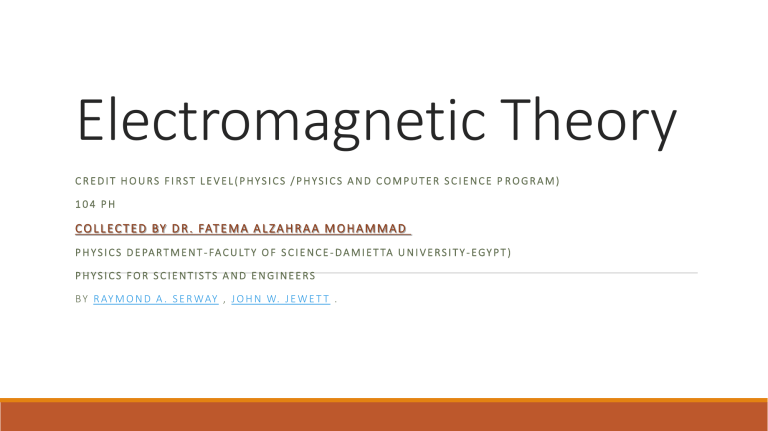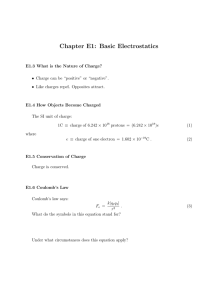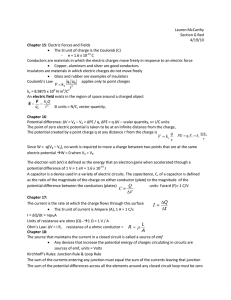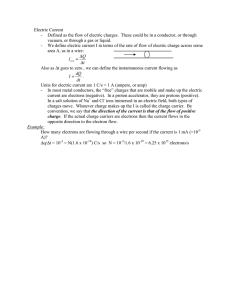
Electromagnetic Theory CREDIT HOURS FIRST LEVEL(PHYSICS /PHYSICS AND COMPUTER SCIENCE P ROGRAM) 104 PH C O L L E C T E D B Y D R . FAT E M A A L Z A H R A A M O H A M M A D P H Y S I C S D E PA R T M E N T - FA C U LT Y O F S C I E N C E - D A M I E T TA U N I V E R S I T Y - E G Y P T ) PHYSICS FOR SCIENTISTS AND ENGINEERS B Y R AY M O N D A . S E R W AY , J O H N W. J E W E T T . Lecture 3 The Electric Field Electric field is defined as the electric force per unit charge. The direction of the field is taken to be the direction of the force it would exert on a positive test charge. The electric field is radially outward from a positive charge and radially in toward a negative point charge. 𝐹 𝐸= 𝑞 𝐹=𝑞𝐸 (SI Units of E are N/C=Volts /m) • It is a vector and its direction can be represented by electric field lines • Let’s look at some simple examples! • http://hyperphysics.phy-astr.gsu.edu/hbase/electric/elefie.html • Electric field around a positive charge +Q +q Test charge +q at separation r feels an outward force 𝑘𝑄𝑞 |𝐹| = 2 𝑟 Electric field is also outward Magnitude of electric field at any point: |𝐹| 𝑘𝑄 |𝐸| = = 2 𝑞 𝑟 Direction of electric field is radially outward • Electric field around a negative charge -Q Magnitude of electric field at any point: |𝐸| = |𝐹| 𝑞 = 𝑘𝑄 𝑟2 Direction of electric field is radially inward • Electric field lines start on positive charges and end on negative charges • The more closely spaced the field lines, the stronger the force • The direction of the field lines show how a positive charge would move if placed at that point. A negative charge would move the opposite way. 𝐸 +q 𝐹 = −𝐸/𝑞 𝐹 = 𝐸/𝑞 -q Problem:Two particles move into the region between charged parallel plates, moving as shown in the diagram. Which of the following combinations is possible? 1. A and B are both electrons 2. A and B are both protons 3. A is a proton, B an electron 4. A is an electron, B a proton 5. No way to determine A E B • Electric field lines between two charges Unlike charges Like charges Consider an electron placed near a pair of identical positive charges, as in the field diagram. If the electron is at position “A” the direction of the force on it is best indicated by which of the following arrows? 1. 2. 3. 4. ↑ ↖ ↘ → What is the force direction at location “B and C”? • Electric field lines between charged plates 𝐸 • A constant electric field is obtained (see later material on capacitors) Example A +5.0 mC charge is located at the origin, and a -2.0 mC charge is 0.74 m away on the x-axis. Calculate the electric field at point P, on the y-axis 0.6 m above the positive charge. If a +1.5 mC was placed at P, what force would it experience? Electric field is superposition of 2 charges E= kq/r2 along joining line, k=9x109 N.m2/C2 P 0.6 0 0.74 Electric field at P due to green charge q = +5x10-6 C P 0.6 𝑘 𝑞 9 × 109 × 5 × 10−6 5 𝑁/𝐶 𝐸= 2 = = 1.25 × 10 𝑟 0.62 𝐸𝑥 , 𝐸𝑦 = (0, 1.25 × 105 ) Direction is along y-axis: 0 Electric field at P due to purple charge q = -2x10-6 C Pythagoras: r2 = 0.62 + 0.742 = 0.91 m2 𝑘 |𝑞| 𝐸= 2 𝑟 P 0.6 r = 0.95 m 𝑘 |𝑞| 9 × 109 × 2 × 10−6 𝐸= 2 = 𝑟 0.952 = 0.20 × 105 𝑁/𝐶 0.74 𝐸𝑥 , 𝐸𝑦 0.6 𝐸𝑥 , 𝐸𝑦 = (𝐸 cos θ , −𝐸 sin θ) = (0.20 × 105 ∗ 0.74/0.95, −0.20 × 105 ∗ 0.6/0.95) 𝐸𝑥 , 𝐸𝑦 = (0.16 × 105 , −0.13 × 105 ) 0.74 Green charge: 𝐸𝑥 , 𝐸𝑦 = (0, 1.25 × 105 ) Purple charge: 𝐸𝑥 , 𝐸𝑦 = (0.16 × 105 , −0.13 × 105 ) Total: 𝐸𝑥 , 𝐸𝑦 = (0.16 × 105 , 1.25 × 105 ) Electric field strength at P: Force: 𝐸= 𝐸𝑥 2 + 𝐸𝑦 2 = 1.26 × 105 𝑁/𝐶 𝐹 = 𝑞𝐸 = 1.5 × 10−6 × 1.26 × 105 = 0.189 𝑁 Linear Charge Density ( SI unit: C/m): 2 Surface Charge Density (SI unit: C/𝑚 ): Volume Charge Density (SI unit: C/𝑚3 ): λ= 𝑄 𝐿 = 𝑑𝑞 𝑑𝑙 Q dq A dA Q dq V dV Superposition of Fields E P E1P E 2P E3P .... +q1 +q2 +q3 r10 E 30 E 20 r20 r30 P E10 kq 3 kq1 kq 2 E P 2 rˆ10 2 rˆ20 2 rˆ30 .... r10 r20 r30 N q1 q3 q2 qi E P k 2 rˆ10 2 rˆ20 2 rˆ30 .... k 2 rˆi0 r20 r30 i 1 ri0 r10 (H.W.) Superposition problem: Find the electric field due to q1, E1 Find the electric field due to q2, E2 E = E1 + E2 ◦ Remember, the fields add as vectors ◦ The direction of the individual fields is the direction of the force on a positive test charge Electric dipole • A pair of positive and negative charges together form an electric dipole Dipole moment • An example in nature is the water molecule H20 Electric dipole • A dipole in an electric field will feel a torque but no net force 𝐸 𝜏 = 𝐹𝑙 sin 𝜃 = 𝐸𝑄𝑙 sin 𝜃 𝜏 =𝐸×𝑝 Electrostatic analyzer • Charged particles will experience a force in an electric field F=qE, hence acceleration a=F/m=qE/m Conductors and Insulators • In metals (e.g. copper, iron) some electrons are weakly held and can move freely through the metal, creating an electric current. Metals are good conductors of electricity. Conductors and Insulators • In metals (e.g. copper, iron) some electrons are weakly held and can move freely through the metal, creating an electric current. Metals are good conductors of electricity. • In non-metals (e.g. glass, rubber, plastic) electrons are strongly held and are not free to move. Non-metals are poor conductors of electricity, or insulators. • Semi-conductors (e.g. germanium, silicon) are half-way between conductors and insulators. Freely moving electrons make metals good conductors of electricity and heat Summary • Matter is made up of positive and negative charges. Electrons/protons carry the elementary charge 1.6 x 10-19 C • Forces between charges are described by Coulomb’s Law 𝑘 𝑞1 𝑞2 𝐹= 𝑟2 𝑘 = 9 × 109 𝑁 𝑚2 𝐶 −2 • Forces from multiple charges sum as vectors • Electric field describes the force-field around charges 𝐹 𝐸= 𝑞 𝐹=𝑞𝐸






